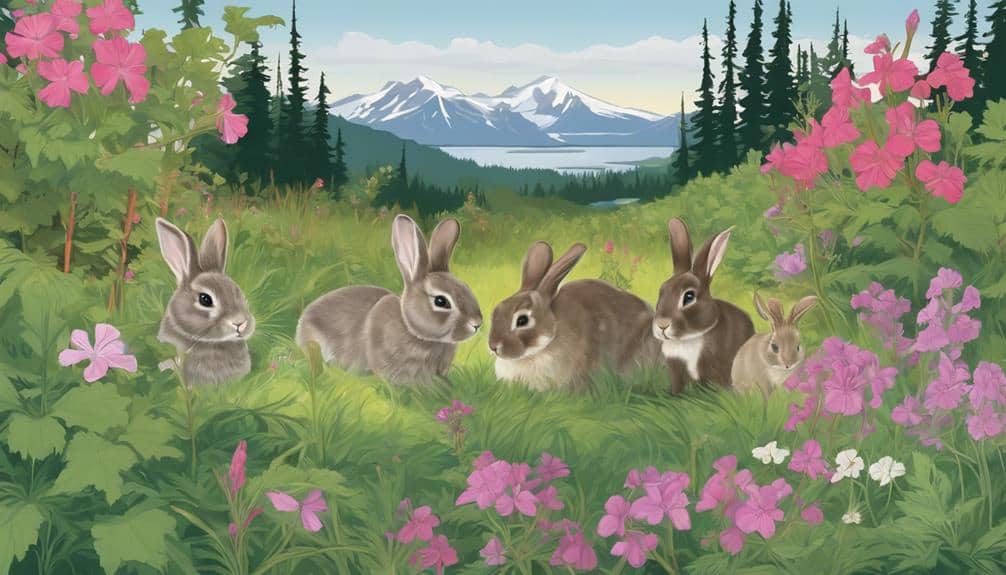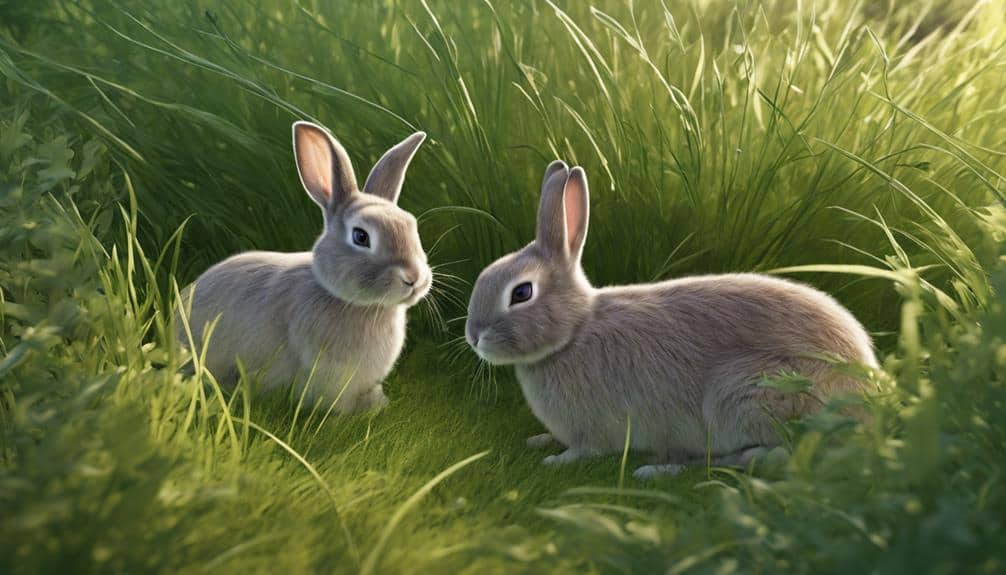In Alaskan bunny habitats, consider planting Jerusalem artichoke tops, wild giant ragweed, and lambs quarters. These resilient plants thrive in the challenging environment. Opt for perennial choices like Butternut, pumpkin, or Hubbard squash, and nutrient-rich greens such as dandelion, alfalfa, and clover. Native plants like ferns, wild strawberries, and fireweed can enrich the bunny's surroundings. Safe options include oregano, mint, parsley, and herbs like dill weed. Create shelter with dense shrubs, low-growing plants, and tall grasses. Fireweed, blueberry bushes, and salmonberry plants are ideal native flora choices. Enhance your bunny's habitat with these plant selections.
Contents
- 1 Key Takeaways
- 2 Resilient Plants for Alaskan Bunny Habitats
- 3 Climate-Adapted Vegetation for Bunny Habitats
- 4 Native Plants for Bunny Enrichment
- 5 Safe and Non-Toxic Plants for Bunnies
- 6 Ideal Vegetation for Bunny Shelter
- 7 Thriving Flora in Bunny Habitats
- 8 What Plants Should I Include in a Wild Bunny Habitat in Alaska?
- 9 Conclusion
Key Takeaways
- Ideal plants include Jerusalem Artichoke Tops, Wild Giant Ragweed, and Lambs Quarters for Alaskan bunny habitats.
- Climate-adapted vegetation like Butternut, Pumpkin, or Hubbard Squash is beneficial.
- Native plants such as Fireweed and Salmonberries enrich bunny habitats.
- Safe options like Oregano, Mint, and Parsley provide non-toxic choices for bunnies.
- Bunny shelters thrive with dense shrubs, low-growing plants, and tall grasses like fescue.
Resilient Plants for Alaskan Bunny Habitats

Resistant plants essential for Alaskan bunny habitats include Jerusalem Artichoke tops, which provide crucial nutrition and are highly favored by rabbits. These plants offer a solid source of energy and essential nutrients for the bunnies, aiding them in thriving in their natural habitat.
Wild giant ragweed is another robust plant that can withstand the harsh Alaskan conditions and acts as a sustainable food source for the rabbits. Its abundance guarantees a consistent food supply for the bunnies throughout the seasons.
Lambs quarters, recognized for their adaptability and nutritional value, are also well-suited for Alaskan bunny habitats. These plants not only provide essential nutrients but also enhance the overall biodiversity of the habitat, creating a more balanced ecosystem for the bunnies to inhabit.
Climate-Adapted Vegetation for Bunny Habitats
In Alaskan bunny habitats, the adaptation of vegetation to the climate plays an essential role in providing sustenance for the resident rabbits. During the harsh winter months, it's important for rabbits to have access to a variety of leafy greens rich in nutrients to survive. Vegetation that can thrive in the Alaskan climate and offer organic matter for the rabbits includes Jerusalem Artichoke tops, wild giant ragweed, and lambsquarters. These plants not only provide essential nutrients but also contribute to the overall health and well-being of the bunny population.
In addition to these, perennial plants like Butternut, pumpkin, or Hubbard squash are excellent choices for rabbit fodder in Alaska due to their adaptability to the climate and high nutritional value. Dandelion, alfalfa, clover, and timothy grass are also crucial sources of nutrients that offer diversity in the rabbits' diet, especially during the challenging winter months. Incorporating pea vines, white clover, pumpkin seeds, sunflower seeds, and radish tops can further supplement the protein intake of rabbits in Alaskan habitats.
Furthermore, elm leaves, oak leaves, honeysuckle, tulip poplar branches, apple branches, and willow leaves provide medicinal benefits and contribute to a varied diet for the rabbits, ensuring their health and vitality in the unique Alaskan environment.
Native Plants for Bunny Enrichment

Native plants commonly found in Alaskan bunny habitats, such as ferns, wild strawberries, and fireweed, play an essential role in enriching the bunnies' environment. These plants provide a diverse range of textures, scents, and flavors for the bunnies to explore and interact with, promoting their physical and mental well-being. By incorporating native plants, you can mimic the bunnies' natural environment, allowing them to forage and engage in natural behaviors, fulfilling their instinctual needs. This creates a sustainable and biodiverse habitat that supports the local ecosystem and wildlife.
- Ferns: Offering a lush and varied landscape for bunnies to navigate and hide among.
- Wild Strawberries: Providing delicious treats for bunnies to enjoy and forage on.
- Fireweed: Adding vibrant splashes of color and attracting pollinators that bunnies can observe.
- Salmonberries: Offering another tasty foraging option rich in essential nutrients.
- Lupine: Creating a visually appealing environment while also being a source of nibbling for bunnies.
Safe and Non-Toxic Plants for Bunnies
When cultivating a bunny garden, prioritize incorporating safe and non-toxic plants to guarantee the health and well-being of your rabbits. Selecting the right vegetation is essential to creating a safe and enriching environment for your furry companions. Below is a table outlining some safe and non-toxic plants that are ideal for your bunny garden:
| Safe and Non-Toxic Plants | Benefits | Notes |
|---|---|---|
| Oregano | Provides fresh food options | Safe for rabbits to nibble on |
| Mint | Adds variety to their diet | Helps with digestion |
| Parsley | Nutritious and flavorful | Feed in moderation |
It is important to avoid toxic plants like foxglove, hemlock, and rhododendron, as they can pose serious health risks to rabbits if consumed. Instead, opt for rabbit-friendly options such as dill weed, sage, and thyme, which not only offer nutritional benefits but also ensure the safety of your bunnies. Including herbs like chives, pot marigold, and lettuce in your bunny garden will provide a diverse and stimulating environment for your rabbits to explore and enjoy. By carefully selecting safe and non-toxic plants, you can promote the overall well-being and vitality of your rabbit companions in their bunny garden.
Ideal Vegetation for Bunny Shelter

Planting dense shrubs like willows or alders will provide bunnies with natural shelters, creating secure hiding spots for them.
Low-growing plants such as clover or timothy grass can offer bunnies places to hide and forage for food.
Incorporating tall grasses like fescue or ryegrass will give bunnies coverage from potential predators, ensuring their safety within their habitat.
Shelter Plant Types
Shrubs such as willow, raspberry, and elderberry are essential for providing ideal shelter for bunnies in Alaskan habitats. These shrubs offer protection from predators and harsh weather conditions, creating a safe haven for the bunnies.
Other vegetation types that contribute to the shelter include:
- Juniper bushes: Their dense foliage provides excellent cover for bunnies to hide and seek refuge.
- Holly bushes: With their prickly leaves, they act as a natural barrier, deterring potential threats.
- Yew bushes: Their low branches and thick foliage offer a secure environment for bunnies to nest and rest.
- Birch trees: These tall trees provide overhead cover and nesting opportunities for bunnies.
- Spruce trees: Their dense branches create a shield against predators and inclement weather, ensuring bunny safety.
Vegetation Coverage Needs
Thick vegetation coverage is crucial for providing secure shelter and protection for Alaskan bunnies from predators in their habitats. In moist soil areas, shrubs play an important role in creating a safe environment for bunnies. The dense foliage of shrubs offers an ideal hiding place, allowing rabbits to blend in and evade potential dangers effectively.
Additionally, a mix of shrubs, bushes, and tall grasses with varying heights and densities provides bunnies with options to build their shelters. This diversity in vegetation coverage guarantees that rabbits can choose the most suitable spots for protection. By incorporating a range of vegetation types, you can help create a habitat that offers ample choices for Alaskan bunnies to thrive and stay safe from predators.
Planting for Protection
To provide ideal protection for Alaskan bunnies in their habitats, contemplate incorporating a variety of native plants known for offering natural shelter and security against predators. When planting for protection, focus on creating a diverse landscape that offers ample hiding spots and coverage for the bunnies.
Here are some key vegetation options to contemplate:
- Dense Shrubs: Willows and alders provide excellent natural shelter from predators.
- Low-Growing Plants: Ferns and moss create a cozy and safe environment for bunnies to hide.
- Thick Ground Covers: Clover or violets offer a secure place for bunnies to rest and forage.
- Tall Grasses: Timothy or orchard grass provide cover while bunnies move around.
- Native Plants: Salmonberry bushes and wild roses contribute to a diverse and protective bunny habitat in Alaska.
Thriving Flora in Bunny Habitats

Rabbits in Alaskan habitats require a variety of native flora to thrive successfully. Recommendations for ideal plants include Jerusalem Artichoke tops, wild giant ragweed, and lambs quarters to provide essential nutrients.
Understanding the planting tips for these flora can have a profound impact on the health and well-being of bunnies in their natural habitat.
Ideal Plants for Bunnies
In Alaskan bunny habitats, an abundance of ideal plants thrives to provide essential nutrients and support peak health for these furry inhabitants.
These plants include:
- Jerusalem Artichoke Tops: Rich in essential nutrients and fiber, aiding in overall health.
- Wild Giant Ragweed: A nutritious choice, offering a natural source of food for bunnies.
- Lambs Quarters: Packed with vitamins and minerals, promoting peak health.
- Butternut, Pumpkin, or Hubbard Squash: Tasty and nutritious treats for bunnies in their natural habitat.
- Dandelion Greens: A favorite among bunnies, providing a delicious and healthy addition to their diet.
These plants contribute to the well-being of bunnies by offering a variety of nutrients essential for their digestive system and overall health in the Alaskan wilderness.
Native Flora Recommendations
Thriving in Alaskan bunny habitats, native flora like fireweed, blueberry bushes, and salmonberry plants play an essential role in providing natural food sources and shelter for these furry inhabitants. Fireweed, with its vibrant pink flowers, is a common sight in Alaskan landscapes, attracting bunnies with its tender leaves.
Blueberry bushes offer juicy berries and nutritious foliage for bunnies to enjoy season-long. Salmonberry plants produce delicious berries that bunnies love to forage on in the wild. These native plants not only provide sustenance but also create a familiar environment for bunnies, promoting their well-being and natural behaviors.
Planting Tips for Success
Consider selecting plant species that exhibit resilience to the cool, maritime climate of Southeast Alaska for best growth in bunny habitats. To guarantee success in planting for your raised rabbits, follow these tips:
- Plant herbs such as oregano, mint, and parsley in well-draining soil with ample sunlight.
- Include nutritious greens like lettuce and Swiss chard that thrive in the region's conditions.
- Opt for perennial plants like Jerusalem artichoke tops and clover for sustainable rabbit fodder.
- Implement organic fertilizers to enrich the soil and support plant growth.
- Consider using soil amendments to create a nurturing environment for your bunny habitat.
What Plants Should I Include in a Wild Bunny Habitat in Alaska?
When creating a wild bunny habitat in Alaska, consider including native plants like willow, birch, and fireweed. These plants provide food and shelter for bunnies and attract insects for them to eat. Creating a diverse habitat increases the chances of spotting wild bunnies in Alaska.
Conclusion
To summarize, when developing habitats for Alaskan bunnies, it's essential to select resilient, climate-adapted, native, safe, and ideal vegetation for their shelter and enrichment.
By incorporating flourishing flora in their habitats, you can guarantee the well-being and happiness of these furry creatures.
Remember, selecting the right plants is vital to providing a suitable environment for Alaskan bunnies to flourish in their natural habitat.






